About
Visit
Museum
Photos
Video
News
Events



STATEHOUSE NEWS

The Capitol Square Review and Advisory Board (CSRAB) and the Capitol Square Foundation today announce the recipients of the 2016 “Great Ohioans Award.” The 2016 honorees were presented by the Capitol Square Foundation and unanimously approved by the CSRAB board. The three individuals were selected from nominations submitted by citizens and organizations throughout Ohio.
The 2016 Great Ohioans are: Jack Nicklaus, professional golfer and entrepreneur, John D. Rockefeller, industrialist and philanthropist and Potter Stewart, U.S. Supreme Court justice.
For detailed information about each honoree, see the biographies below.
High resolution images of each of the recipients will be available at: ohiostatehouse.org/galleries/great-ohioans.
“As we mark the 20th anniversary of the completion of the Ohio Statehouse restoration in 2016, I believe this class of Great Ohioans will serve to inspire future generations of Ohio leaders and represents the great wealth of talent that the Buckeye State has produced since statehood in 1803,” said Speaker of the Ohio House Cliff Rosenberger, Chairman of the Capitol Square Review and Advisory Board.
The Great Ohioan Award commemorates Ohioans who have played a significant role in an event or series of events of lasting significance in World, American or Ohio history. To be selected for the Great Ohioan Award, the nominee must have resided in Ohio for a minimum of five years. In addition, at least 25 years must have passed since the event in which the nominee participated is being commemorated.
BIOGRAPHIES OF THE 2016 GREAT OHIOAN AWARD WINNERS
Potter Stewart
Potter Stewart, U.S. Supreme Court justice, was born in Jackson, Michigan, the son of James Garfield Stewart, a chief justice of the Supreme Court of Ohio, and Harriet Loomis Potter. Stewart was chairman of the undergraduate newspaper at Yale University, where he received a bachelor's degree in 1937 and a law degree in 1941. After serving during World War II as a naval officer and attaining the rank of lieutenant junior grade, he entered private practice and local politics in Cincinnati
.
In 1954, when Stewart was only 39, he was appointed to the U.S. Court of Appeals for the 6th Circuit. In 1958, President Dwight D. Eisenhower appointed him to the U.S. Supreme Court, where he served until his retirement in 1981. Although he had a background in Ohio Republican politics and was appointed to the Supreme Court by a Republican president known for his antipathy to judicial liberalism, Stewart was not a conservative justice. Rather, he followed a moderate, pragmatic approach that defied easy categorization. He believed that he should approach each case on its merits, without striving to further an ideological agenda. Over time, his practical approach marked him as a centrist who adhered to no particular wing of the court.
Stewart's 23-year tenure on the Supreme Court roughly coincided with the eras of chief justices Earl Warren and Warren Burger. On the Warren Court, Stewart frequently stood outside the prevailing liberal consensus, particularly on matters concerning state criminal law enforcement. His centrist inclinations meant, however, that he also declined to align himself with the Burger court's occasionally aggressive pursuit of politically conservative causes.
In 1968, when Warren announced his intention to retire, Stewart removed himself from consideration for the position of chief justice, mindful of the internal dissension that had been generated when members of the court previously had sought the position. He later played a significant role in formulating the court's unanimous opinion in Nixon v. United States (1974), which ordered President Richard M. Nixon to surrender to the special prosecutor the tape recordings whose disclosure later led Nixon to resign. He died in Hanover, New Hampshire.
John D. Rockefeller
John Davison Rockefeller Sr. was an American industrialist and philanthropist. He was a co-founder of the Standard Oil Company, which dominated the oil industry and was the first great U.S. business trust. Rockefeller revolutionized the petroleum industry, and along with other key contemporary businessmen such as Andrew Carnegie, defined the structure of modern philanthropy. In 1870, he founded Standard Oil Company and actively ran it until he officially retired in 1897.
Rockefeller founded Standard Oil as an Ohio partnership with his brother William along with Henry Flagler, Jabez A. Bostwick, chemist Samuel Andrews, and a silent partner, Stephen V. Harkness. As kerosene and gasoline grew in importance, Rockefeller's wealth soared and he became the world's richest man and the first American worth more than a billion dollars, controlling 90% of all oil in the United States at his peak. Adjusting for inflation, his fortune upon his death in 1937 stood at $336 billion, accounting for more than 1.5% of the national economy, making him the richest person in U.S. history.
His fortune was mainly used to create the modern systematic approach of targeted philanthropy. He was able to do this through the creation of foundations that had a major effect on medicine, education and scientific research. His foundations pioneered the development of medical research and were instrumental in the eradication of hookworm and yellow fever.
Rockefeller was also the founder of both the University of Chicago and Rockefeller University and funded the establishment of Central Philippine University in the Philippines. He was a devoted Northern Baptist and supported many church-based institutions. Rockefeller adhered to total abstinence from alcohol and tobacco throughout his life. He was a faithful congregant of the Erie Street Baptist Mission Church, where he taught Sunday school, and served as a trustee, clerk, and occasional janitor. Religion was a guiding force throughout his life, and Rockefeller believed it to be the source of his success.
Jack Nicklaus
Jack William Nicklaus nicknamed "The Golden Bear", is a retired American professional golfer. He is widely regarded as the greatest professional golfer of all time, winning a total of 18 career major championships, while producing 19 second- place and 9 third-place finishes in them, over a span of 25 years. Nicklaus focused on the major championships (Masters Tournament, U.S. Open, Open Championship, and PGA Championship), and played a selective schedule of regular PGA Tour events, yet still finished with 73 victories, third on the all-time list behind Sam Snead (82) and Tiger Woods (79).
After winning two U.S. Amateurs in 1959 and 1961, and challenging for the 1960 U.S. Open (he finished in second place, two shots behind winner Arnold Palmer), Nicklaus turned professional at age 21 toward the end of 1961. The 1962 U.S. Open was both Nicklaus' first major championship victory and his first professional win. This win over Arnold Palmer began the on-course rivalry between the two golf superstars. In 1966, Nicklaus won the Masters Tournament for the second year in a row, becoming the first golfer to achieve this, and also won The Open Championship, completing his career slam of major championships. At age 26, he became the youngest to do so at the time. In 1968 and 1969, Nicklaus did not win a major tournament. He then won another Open Championship in 1970.
Between 1971 and 1980, he would win an additional nine major championships, overtake Bobby Jones' record of 13 majors, and become the first player to complete double and triple career slams of golf's four professional major championships. At the age of 46, Nicklaus claimed his 18th and final major championship at the 1986 Masters Tournament, becoming that championship's oldest winner.
Nicklaus has also taken part in various off-course activities, including golf course design, charity work and book writing. Nicklaus is a member of the American Society of Golf Course Architects and has helped design courses such as Harbour Town Golf Links. Nicklaus also runs his own tournament on the PGA Tour, the Memorial Tournament. His golf course design company is one of the largest in the world. Nicklaus' books vary from instructional to autobiographical, with his Golf My Way considered one of the best instructional golf books of all time; the video of the same name is the best-selling golf instructional to date.
Since 2003, 39 other Great Ohioans have been recognized with the award for the special roles they played in history. “This year we honor three individuals who have left their mark on Ohio and the nation. Through superb work and performance in athletics, business, philanthropy and law all three honorees have earned the title of Great Ohioan,” said William Carleton CSRAB executive director.
GREAT OHIOAN AWARD RECIPIENTS:
ohiostatehouse.org/galleries/great-ohioans
“Through their accomplishments, each Great Ohioan has changed the trajectory of the State of Ohio, the United State and the world. We hope that every Statehouse visitor is inspired by the life and accomplishments of each one of the men and women who have been recognized with this honor,” said Capitol Square Foundation Chairman Charles Moses.
Great Ohioan honorees and their achievements are archived in a permanent Great Ohioan exhibit, which is part of the Ohio Statehouse Museum. While countless Ohioans have performed great actions for their community and beyond, only a select few have been named a “Great Ohioan.” This exhibit allows visitors to have a greater understanding of the recipients of the Great Ohioan award and discover how they affected local, national and world history. The exhibit uses videos, photos, facts and web based technology to explore the life and legacy of each Great Ohioan.
Opened in 2009, the Ohio Statehouse Museum features high-tech, interactive exhibits that make learning about all three branches of state government immersive. The museum is packed with historical artifacts and images that detail how government works and who has come to serve their fellow citizens.
The Museum includes 5,000 square feet of exhibit space on the ground floor of the Ohio Statehouse that enriches the experience of school children and visitors. The Museum offers exhibits that encourage visitors to participate in the government process by making choices, expressing their opinions, comparing viewpoints and even becoming a part of an exhibit by giving a State of the State address. The museum’s “deep dive” approach to education enables visitors to better relate to the governing process.
To view this press release and others, visit ohiostatehouse.org.
About the Capitol Square Review and Advisory Board
The Capitol Square Review and Advisory Board is responsible for maintaining the historic character of the Statehouse and Capitol Square while providing for the health, safety and convenience of those who work in or visit the complex. The Ohio Statehouse Museum Education Center coordinates tours of Capitol Square and provides information about the buildings, their history and Ohio's government.
The Ohio Statehouse shines a light on the history of this great edifice, its symbolic meaning and its vital historic and ongoing connections to the daily lives of all Ohioans.
About the Capitol Square Foundation
The Capitol Square Foundation was established in 1987 to increase public awareness of and to involve citizens in the history of the Ohio Statehouse. Its purpose is to raise funds to obtain, restore and maintain artifacts and other items related to the history and enhancement of the grand monument and its adjoining grounds, so that the seat of Ohio's government may reflect the dignity of the state and its citizens.
# # #
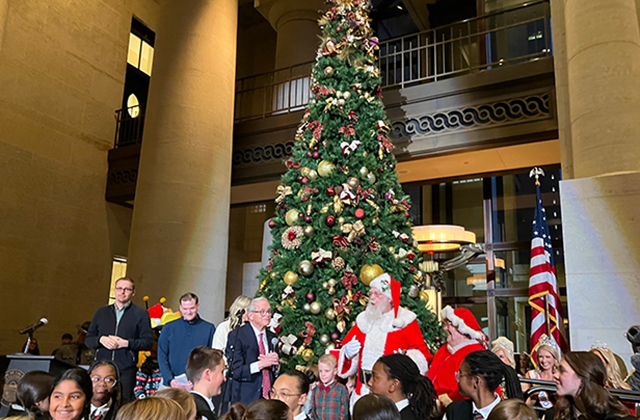 Holiday Festival and Tree Lighting 2025
Holiday Festival and Tree Lighting 2025 Holiday Santa Photos 2025
Holiday Santa Photos 2025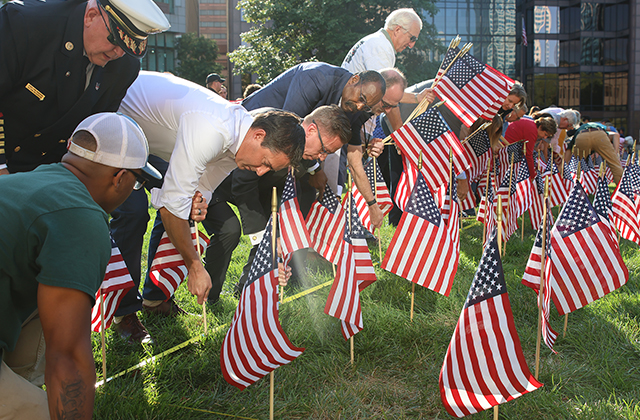 Flags for 9-11 in 2025
Flags for 9-11 in 2025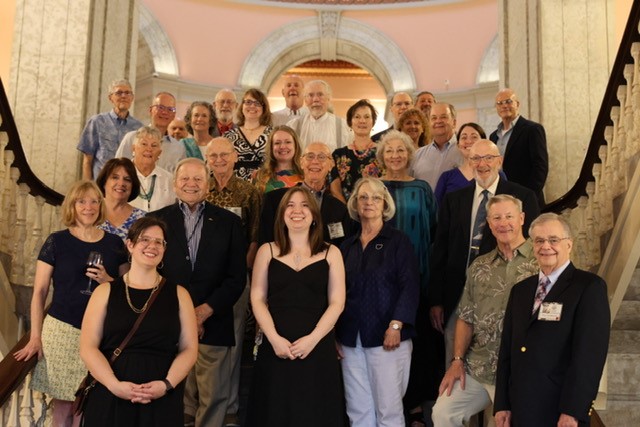 2025 Volunteer Appreciation Dinner
2025 Volunteer Appreciation Dinner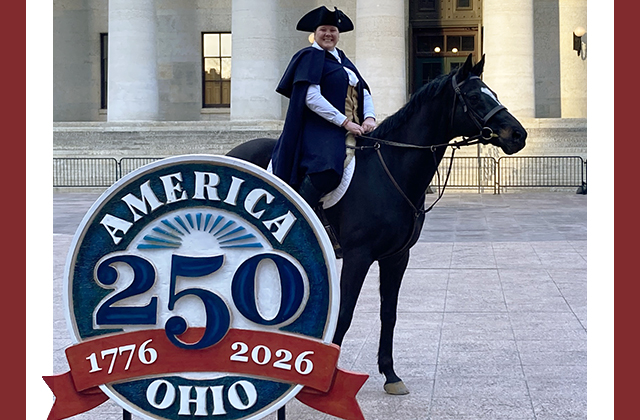 America 250-Ohio
America 250-Ohio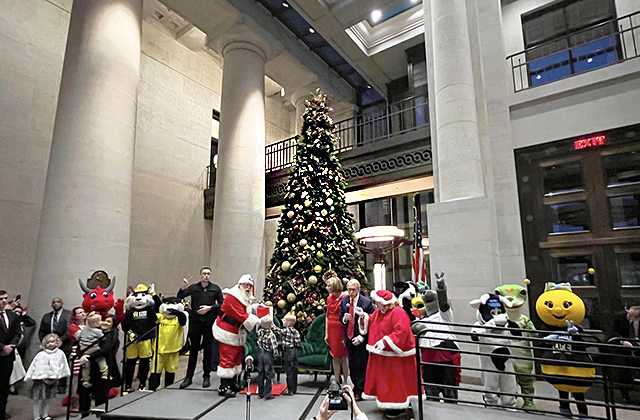 Holiday Festival and Tree Lighting 2024
Holiday Festival and Tree Lighting 2024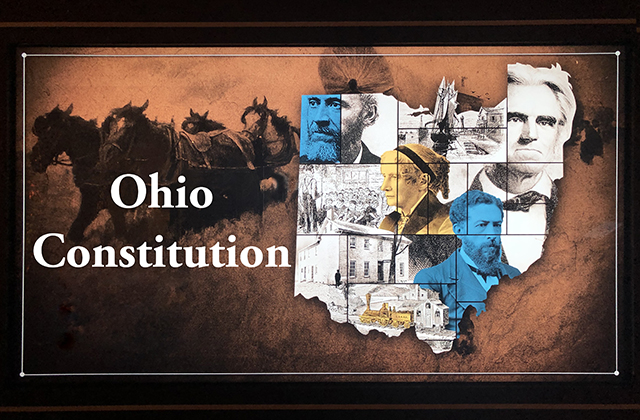 Ohio Constitution Videos
Ohio Constitution Videos Ohio Statehouse Videos
Ohio Statehouse Videos






